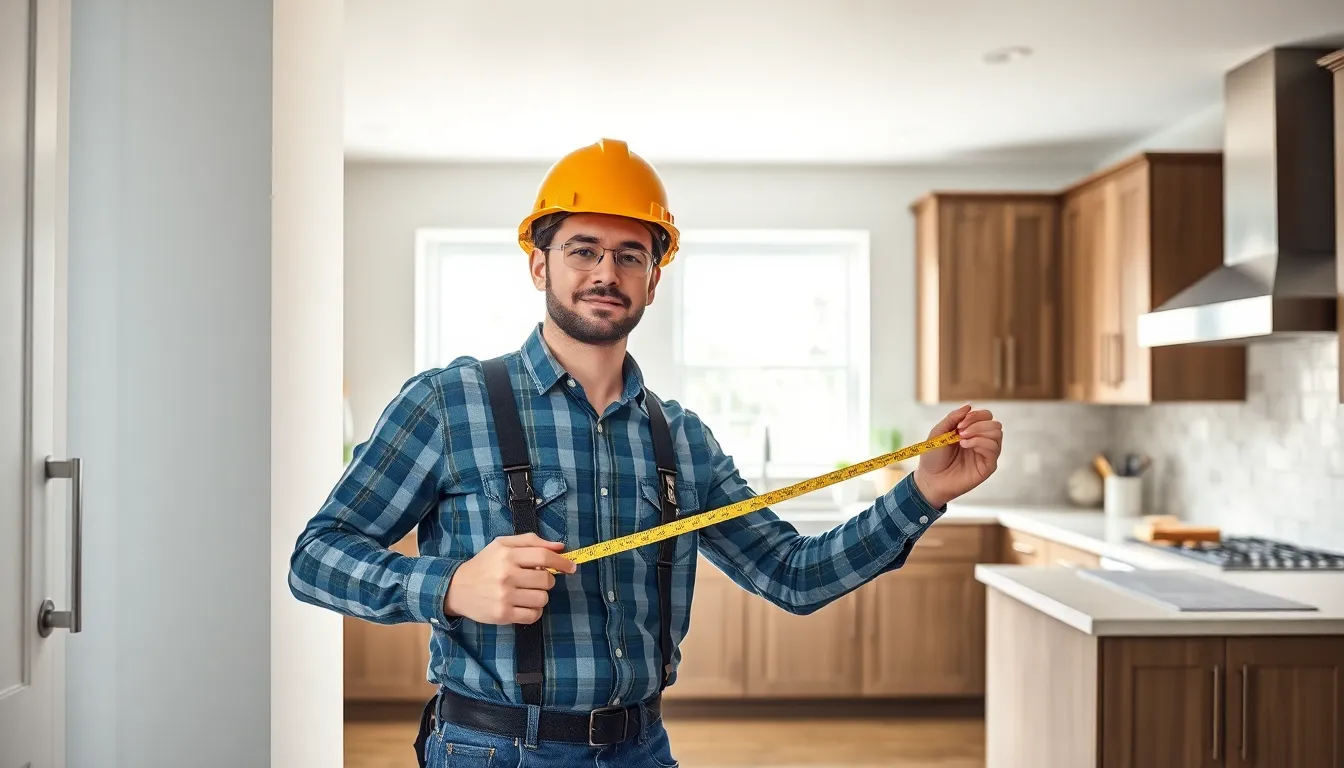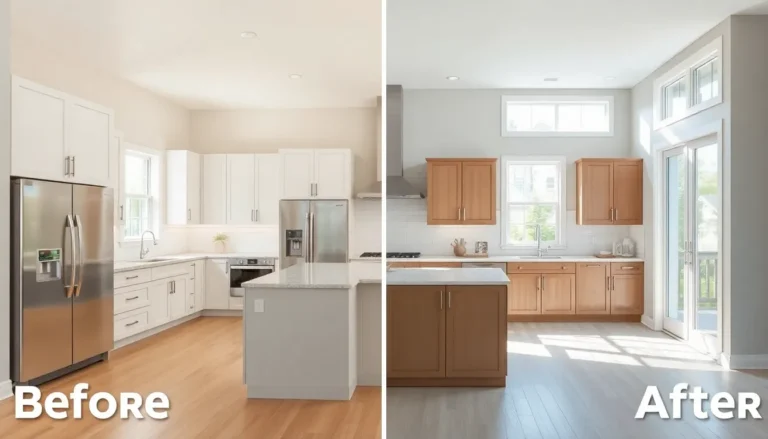Table of Contents
ToggleWhen it comes to home improvement, the word “remodel” often gets tossed around like a hot potato at a family reunion. But what does it really mean? Is it just a fancy term for slapping on a new coat of paint or does it involve a full-blown construction circus? Spoiler alert: it’s more than just a paint job.
What Does It Mean To Define Remodel?
Defining remodel involves understanding the significant changes made to a space. Remodeling encompasses alterations that improve functionality, aesthetics, or both for specific areas within a home. This process typically includes structural changes, thus differentiating it from simple renovations or updates.
Homeowners often consider a remodel when seeking to enhance the flow and usability of a layout. Some examples of remodeling include removing walls to create an open floor plan or reconfiguring a kitchen to improve workflows. Each project may prioritize specific user needs, such as increasing storage or modernizing outdated designs.
Remodeling projects usually call for professional expertise. Architects or designers often work with homeowners to ensure that structural integrity stays intact. The aim remains focused on maximizing value and comfort while reflecting personal style.
When evaluating the term remodel, it’s crucial to differentiate it from maintenance tasks. Everyday upkeep like painting or replacing fixtures doesn’t fall under this category. Instead, remodel involves a more comprehensive approach to transforming a space, both in function and appearance.
Remodel signifies extensive changes aimed at improving living spaces. Addressing practical needs while enhancing aesthetic appeal defines its essence. Understanding this distinction clarifies the scope and impact of remodeling projects in the realm of home improvement.
Key Components of Remodeling

Remodeling comprises several essential components, prominently featuring structural changes and aesthetic enhancements.
Structural Changes
Structural changes form the backbone of a remodel. These modifications often involve altering walls, floors, or ceilings to improve space efficiency. Removing or adding walls creates open floor plans, maximizing natural light and enhancing flow. It’s common for homeowners to consult structural engineers for significant changes, ensuring safety and compliance with building codes. Reinforcing foundations or upgrading plumbing and electrical systems frequently accompanies these renovations, addressing long-term functionality. Each adjustment aims to enhance the usability and enjoyment of a space.
Aesthetic Enhancements
Aesthetic enhancements focus on the visual appeal of a space. Homeowners often select new flooring, cabinetry, or fixtures to update their interiors. Paint colors significantly influence mood and perception, making this choice critical in remodeling projects. Lighting fixtures likewise play a pivotal role, as they highlight features and create ambiance. Decorative elements such as backsplash tiles in kitchens or accent walls in living rooms add personal character. These enhancements blend with structural improvements to create a cohesive and inviting environment. Overall, aesthetic decisions directly impact how individuals experience their homes.
Common Types of Remodels
Remodeling encompasses various types of projects, each tailored to improve specific areas of a home. Below are the most common types homeowners often pursue.
Kitchen Remodels
Kitchen remodels emphasize functionality and aesthetics. Homeowners often redesign layouts to enhance workflow. Popular updates include installing new cabinetry, countertops, and appliances. Adding an island can create additional prep space and seating. Incorporating energy-efficient appliances helps reduce utility costs. Lighting choices, such as pendant or recessed fixtures, set the ambiance. Homeowners frequently opt for open-concept designs to connect dining areas with kitchens, fostering social interaction.
Bathroom Remodels
Bathroom remodels focus on comfort and efficiency. Homeowners may choose to expand existing spaces or reconfigure layouts for optimal use. Common updates include modern vanities, upgraded lighting, and enhanced storage options. Showers often replace tubs for space efficiency and accessibility. Advanced fixtures, like dual-flush toilets, contribute to water conservation. Tile selections and color palettes play significant roles in creating inviting atmospheres. Improving ventilation systems can also enhance air quality and comfort.
Home Additions
Home additions provide extra space tailored to specific needs. Many homeowners opt for extensions, adding bedrooms, sunrooms, or family rooms. Basements often get finished to create additional living areas. Strategic planning ensures that additions blend seamlessly with existing structures. Local building codes and regulations determine design options and materials. Professionals frequently assist with architectural plans and structural considerations. Maximizing natural light with windows and open designs enhances the functionality of new spaces.
Benefits of Remodeling
Remodeling offers numerous advantages for homeowners looking to enhance their living spaces. Increased property value stands out as a significant benefit, with well-executed remodels often yielding substantial returns on investment. Enhanced functionality accompanies these improvements, enabling more efficient use of spaces tailored to specific needs.
Improved aesthetics play a crucial role in remodeling as well. Attractive interiors not only create inviting environments but also enhance overall enjoyment of the home. Updating designs and materials adds visual appeal, transforming dated spaces into contemporary havens.
Energy efficiency emerges as another key advantage. Modern appliances, windows, and insulation contribute to lower utility bills while reducing a home’s environmental impact. Homeowners frequently experience heightened comfort due to better climate control achieved through these upgrades.
Accessibility holds importance, particularly for aging homeowners or those with mobility challenges. Remodels that incorporate universal design principles ensure that spaces remain usable and safe for everyone. Features like zero-entry showers or wider doorways allow for seamless navigation throughout the home.
Customization enables homeowners to reflect personal tastes. Tailored designs allow individuals to express their unique styles, resulting in spaces that feel distinctly theirs. Custom features like built-in storage or specialized layouts further enhance daily functionality.
Overall, these benefits collectively underscore why remodeling represents a valuable investment in any home. From boosting property value to enhancing comfort, every remodeling project has the potential to create a more enjoyable and efficient living environment.
Conclusion
Remodeling is a transformative process that significantly enhances both functionality and aesthetics in a home. By understanding the depth of what remodeling entails homeowners can make informed decisions that align with their needs and preferences. From structural changes to aesthetic upgrades every aspect plays a crucial role in creating a space that feels both comfortable and personalized.
Investing in a remodel not only boosts property value but also improves the overall living experience. With the right professionals guiding the way homeowners can achieve a seamless blend of style and practicality. Ultimately remodeling is more than just a project; it’s an opportunity to redefine one’s living space and lifestyle.





